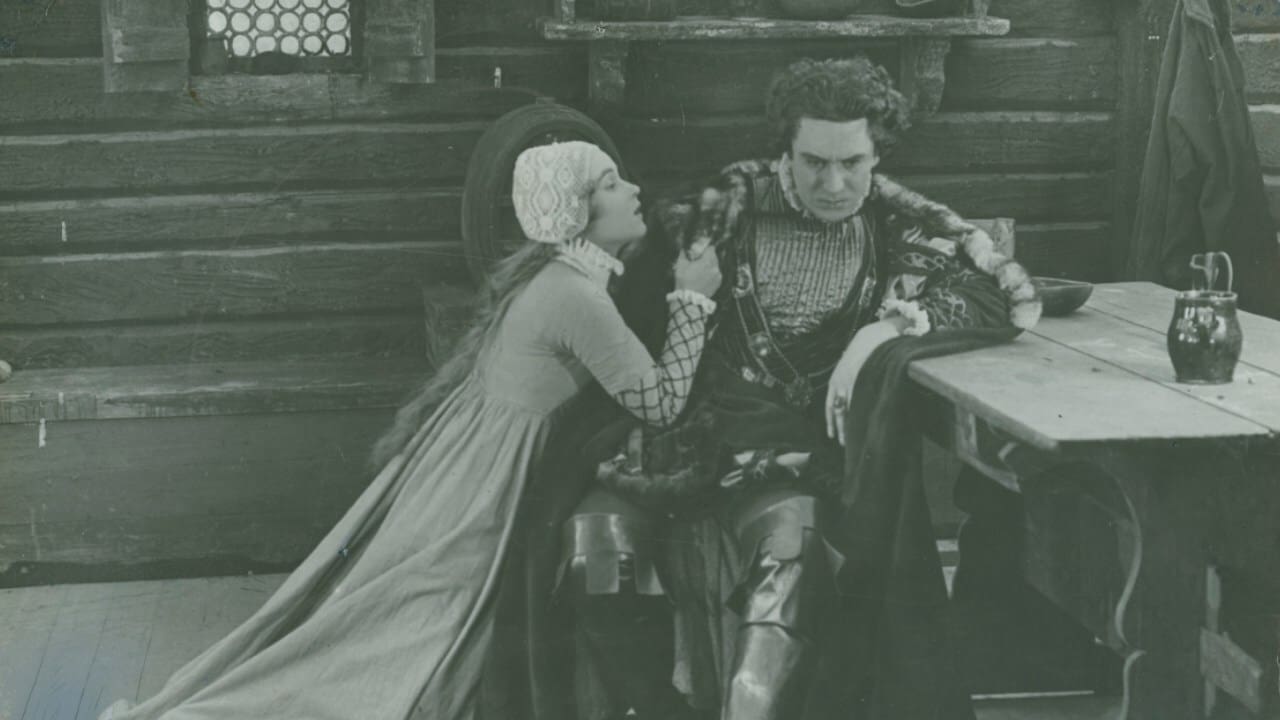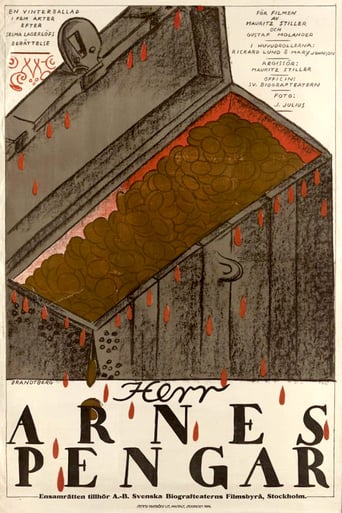

Technically speaking, this is a well-made film--especially for 1919. Yet despite this, I found myself curiously unengaged in the film. I think a lot of this is the plot, as it has two problems. First, it's unrelentingly depressing and the characters are hard to care for one way or the other. Second, the main bad guy and the woman he subsequently falls in love with are both ill-defined characters and both behave very inconsistently.The film starts in Sweden centuries ago. Large numbers of Scottish mercenaries had come there to work in the service of the king. However, some sort of falling out occurs. While most of these men flee the country, three Scots are locked up together. They eventually kill their jailers and escape. Considering it's winter and a harsh one at that, the fact that the three manage to survive to the border is amazing.Hungry and dehumanized, the trio learn of a rich man named Sir Arne who has a huge treasure chest. They take him and his family prisoner--eventually killing all of them (or so they think). One, a young lady, hides and manages to avoid death. Despite this traumatic incident, the lady oddly cannot readily identify the three murderous thieves--so when she meets and falls in love with one of them only days or weeks later, it makes little sense. Also what makes little sense is that almost all of this powerful action isn't shown! Perhaps it originally did and was simply lost over time--a common occurrence with silent films. But, without these scenes the movie just seems a bit lacking.Eventually, when the lady does learn that her depression and agony was caused by the man she now loves, she responds in an odd way. She STILL loves him! And, odder still, this supposedly transformed man who has turned over a new leaf quickly betrays this woman AGAIN--using her as a human shield to make his escape when the authorities come to arrest him for murder! Eventually, he manages to make it to a waiting boat but it is stuck in the ice--the intervention, apparently, by God who wants the three men caught and punished for their wickedness.What has the film going for it? Well, for a print over 90 years old, it sure is in excellent shape. It's obvious that the folks who restored the print did a great job. Plus, some of the cinematography was very nice. I was particularly impressed by the fine winter scenes--it must have been really tough filming in such inclement weather. But, on the negative side, the story often makes little sense as the characters behave strangely. And, often, the action is muted by the style in which the film was made. Finally, being unrelentingly depressing, this film is NOT one to show to anyone clinically depressed--it might just send them over the edge!
... View MoreI suppose no one can understand film at all without knowing the poles of narrative.One of the dimensions is whether the world is beside the story and viewed by it. Or in some other relationship. The Swedes own one of these poles, their narratives always being buried by heavy fate and guilt about it. Its a very strange thing to see from the outside.The nature of Swedish narrative survives today, because they are so good at nurturing and presenting it. And we watch it for some reason, possibly because of the lightness of being outside the curse. The story here is of three alien murderers who decimate a peaceful household for the titular treasure. One of these thugs later falls in love with the soul surviver, a pretty girl.She feels guilty for surviving, he for murdering and both for falling in love. The meaty part of the story is toward the end where guilt drives fate and the world comes crashing down on them. The whole world contrives against them. Weather freezes. The two societies in play turn against them. Death. Death, but the deaths aren't the greatest tragedy: it is the curse of entanglement, the knowing, and the knowing that others know. And of course those others as a society are cursed.There are many dark images in this. But the key one must be one of the most memorable in all cinema. The getaway ship is frozen in the ice, Shackleton-like. The entire population of the area's women and children stream across the ice intent on recovering her, though they know she has assisted the murderer. The crew turns against their passengers believing them to be the cause of a curse. The weather.That endless stream of dark, determined villagers do indeed recover the girl, a corpse, and stream back home while the ice is dissolving right behind them. Its pretty darn entangling, and conveys the curse. No watchers, only participants.Ted's Evaluation -- 3 of 3: Worth watching.
... View MoreVery unusual and extremely well done film set during a bitterly cold winter in 16th century Sweden, where three Scottish soldiers of fortune, arrested and imprisoned in "the tower", escape and then hide their identities by wearing hides (and Santa Claus hats) as they pretend to be journeyman tanners roaming the countryside looking for work. But soon these three have committed a horrific crime - murdering an entire household, they steal the treasure chest of Sir Arne, town vicar, rumored to be filled to the brim with silver coins. The only survivor of this terrible bloodbath is an innocent young maiden named Elsalill, who is taken to live with a fish hawker and his wife. But soon she meets one of the men (the youngest and most handsome, of course) who was involved in the crime and begins to have a relationship with him, not knowing who he is - and both are soon haunted by dreams and nightmares of the crime.This film is gripping, haunting, and beautifully photographed, the outdoor scenes in the ice and snow looking just like stark and gloomy picture postcards. Especially memorable in my mind is the scene of Elsalill's dream with the ghost image of her young foster sister who was murdered sort of floating along near her as she walks. The DVD of this features an amazing looking print, brightly tinted in mostly blue and deep sepia perfectly reflecting the bitter cold outdoors and the warmer rooms of the indoor scenes. The music score is excellent as well, and helps set the mood, along with the costuming and period settings, to make this film really feel like a step back to another place and time.
... View MoreAs a title in film history books, Sir Arne's Treasure always seemed like it must fall somewhere between Die Nibelungen and Ivanhoe-- an epic knightish adventure with a heavier Scandinavian feel. In fact it's a tale of guilt and doom in the classic Swedish mode, almost a chamber piece despite its grandiose division into five acts, set in an historical setting but with some of the same distilled focus and sense of inevitability as, to pick a recent example, Cronenberg's A History of Violence. Three Scottish mercenaries (the main one, incongruously, given the jaunty name "Sir Archie"; happily his compatriots are not Sir Reggie and Sir Jughead) escape from captivity in 16th century Sweden and, driven half-mad by the winter winds and starvation, wind up slaughtering the entire household of a local lord for his treasure. Only one young, Lillian Gish-like girl, Elsalill, who hides herself during the crime, escapes-- but, being Swedish, is consumed by survivor's guilt. This being one of those stories (like Crash or Dickens' Bleak House) where there are only eight different people in the entire country, the three, newly kitted out in finery, return to the scene of the crime and Sir Archie promptly falls in love with the survivor of his depredations and starts having guilt of his own. I'm betting you can pretty much guess how that's going to work out for the gloomy couple. The initial acts of Sir Arne's Treasure take a little mental adjustment, as there's what we might call a high Guy Maddin quotient here, of over-the-top Nordic gloom-- the old crone (Mrs. Sir Arne) repeatedly shrieking "Why are they sharpening the knives at Brorhaven?" at the dinner table, the use of the phrase "fish wench" in a title, or a ship captain who believes that his ship is frozen in ice as God's punishment for some big crime he can't QUITE put his finger on.... The latter in particular shows the heavily moralistic hand of Selma Lagerlof (who also wrote Gosta Berling, The Phantom Chariot, etc.), who was good at setting up ripping plot mechanics but tended to impose a Victorian religious sensibility which you don't see in the best Swedish films, such as Sjostrom's The Outlaw and His Wife. While there's a stark, In Cold Blood-like quality to the depiction of these violent events in a remote, snowbound location, we're impressed by the dramatic quality of the events themselves, not by any human sympathy that has particularly been built up for the characters to that point. And it is easy to see why distributors in other countries succumbed to the temptation to trim the film down, as Stiller allows many of the events to play out in real time, even when relatively little is going on. It's when the film narrows its focus to the two main characters and their guilt-racked interactions that Stiller's deliberate storytelling begins to really justify itself-- the film is like the long walk to the electric chair in a Cagney movie from that point on, and the minutely detailed depiction of everyday activities not only makes the historical setting seem vividly real, but serves to cut off the possibility of outlandish movie-style heroics which will bring the story to any end other than the inevitable tragic one (which, nevertheless, contains a couple of shocking turns which wouldn't have passed muster for Errol Flynn at Warner Brothers in 1938). Mention must be made (as theater reviewers say when they can't think of a better transition) of the cinematography of Julius Jaenzon, who pretty much shot everything that was anything in Swedish silent cinema. The word inevitably attached to Jaenzon's work is "landscape," which is to say, he and Stiller and Sjostrom were all masterful at using the forbidding country they lived in to help set the emotional tone of their scenes. When they want you to feel that someone's lonely, they stick him out walking on an icy fjord and by God, he's LONELY. Also, as we all know, the moving camera as an expressive device (rather than just a way of showing off your fancy set, as in Intolerance) wasn't invented until The Last Laugh in 1924, so we can all throw out those pages of our film history books since one of the most striking things about this film is the extensive use of the moving camera throughout. Since the moving camera tends to imply the presence of the director and thus to deny the possibility of free will for the characters (which is why it works so well in things like noirs, or Max Ophuls' adaptations of Schnitzler, or Kubrick movies about unstable hotel caretakers being taken over by malevolent ghosts), it's a perfect artistic choice for this story, and one that strongly reinforces the atmosphere of destiny and doom while also keeping our focus on the mental state of characters who remain front and center within the shot, rather than on how they physically move from one place to another within a shot.
... View More